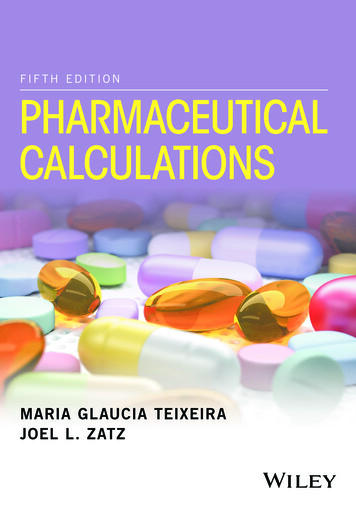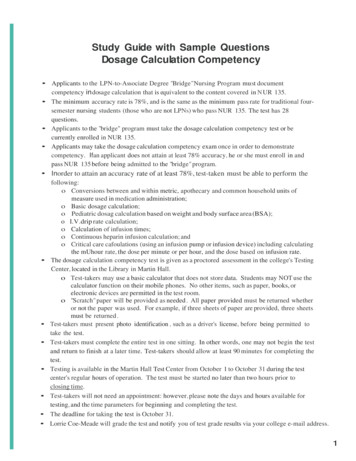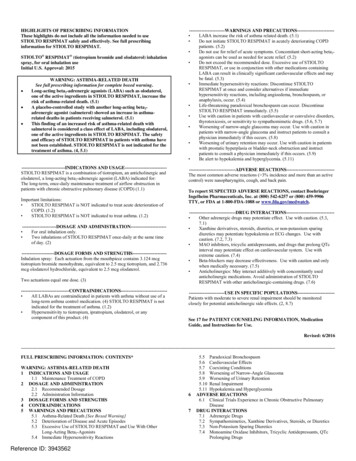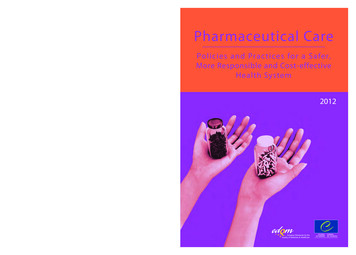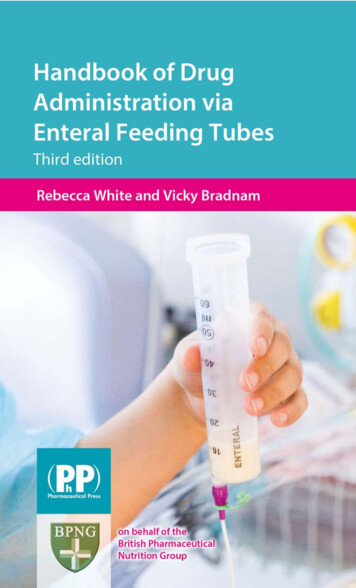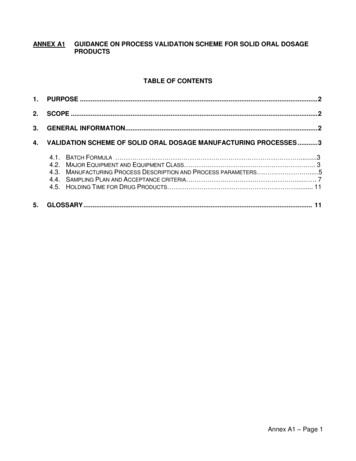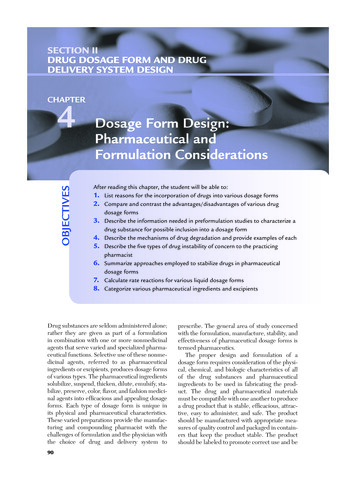
Transcription
SECTION IIDRUG DOSAGE FORM AND DRUGDELIVERY SYSTEM DESIGNCHAPTEROBJECTIVES4Dosage Form Design:Pharmaceutical andFormulation ConsiderationsAfter reading this chapter, the student will be able to:1. List reasons for the incorporation of drugs into various dosage forms2. Compare and contrast the advantages/disadvantages of various drugdosage forms3. Describe the information needed in preformulation studies to characterize adrug substance for possible inclusion into a dosage form4. Describe the mechanisms of drug degradation and provide examples of each5. Describe the five types of drug instability of concern to the practicingpharmacist6. Summarize approaches employed to stabilize drugs in pharmaceuticaldosage forms7. Calculate rate reactions for various liquid dosage forms8. Categorize various pharmaceutical ingredients and excipientsDrug substances are seldom administered alone;rather they are given as part of a formulationin combination with one or more nonmedicinalagents that serve varied and specialized pharmaceutical functions. Selective use of these nonmedicinal agents, referred to as pharmaceuticalingredients or excipients, produces dosage formsof various types. The pharmaceutical ingredientssolubilize, suspend, thicken, dilute, emulsify, stabilize, preserve, color, flavor, and fashion medicinal agents into efficacious and appealing dosageforms. Each type of dosage form is unique inits physical and pharmaceutical characteristics.These varied preparations provide the manufacturing and compounding pharmacist with thechallenges of formulation and the physician withthe choice of drug and delivery system toprescribe. The general area of study concernedwith the formulation, manufacture, stability, andeffectiveness of pharmaceutical dosage forms istermed pharmaceutics.The proper design and formulation of adosage form requires consideration of the physical, chemical, and biologic characteristics of allof the drug substances and pharmaceuticalingredients to be used in fabricating the product. The drug and pharmaceutical materialsmust be compatible with one another to producea drug product that is stable, efficacious, attractive, easy to administer, and safe. The productshould be manufactured with appropriate measures of quality control and packaged in containers that keep the product stable. The productshould be labeled to promote correct use and be90Chap04.indd 9010/22/2009 8:40:52 PM
CHAPTER 4 PHARMACEUTICAL AND FORMULATION CONSIDERATIONSstored under conditions that contribute to maximum shelf life.Methods for the preparation of specific typesof dosage forms and drug delivery systems aredescribed in subsequent chapters. This chapterpresents some general considerations regardingphysical pharmacy, drug product formulation,and pharmaceutical ingredients.THE NEED FOR DOSAGE FORMSThe potent nature and low dosage of most of thedrugs in use today precludes any expectation thatthe general public could safely obtain the appropriate dose of a drug from the bulk material. Mostdrug substances are administered in milligramquantities, much too small to be weighed on anything but a sensitive prescription or electronic analytical balance. For instance, how could the layperson accurately obtain from a bulk supply the91325 mg of aspirin found in the common tablet?Not possible. Yet compared with many otherdrugs, the dose of aspirin is formidable (Table 4.1).For example, the dose of ethinyl estradiol, 0.05 mg,is 1/6,500 the amount of aspirin in an aspirin tablet. To put it another way, 6,500 ethinyl estradioltablets, each containing 0.05 mg of drug, could bemade from an amount of ethinyl estradiol equal tothe amount of aspirin in just one standard tablet.When the dose of the drug is minute, as with ethinyl estradiol, solid dosage forms such as tabletsand capsules must be prepared with fillers ordiluents so that the dosage unit is large enough topick up with the fingertips.Besides providing the mechanism for the safeand convenient delivery of accurate dosage, dosage forms are needed for additional reasons: To protect the drug substance from thedestructive influences of atmospheric oxygenor humidity (coated tablets, sealed ampuls)TABLE 4.1 SOME DRUGS WITH RELATIVELY LOW USUAL DOSESDRUGBetaxolol HClClotrimoxazoleMethylphenidate HClMedroxyprogesterone acetateMesoridazine besylateMorphine sulfateNifedipineOmeprazoleQuinapril HClChlorazepate dipotassiumBuspirone HClEnalapril maleateHydrocodonePrednisoloneAlbuterol sulfateChlorpheniramine maleateFelodipineGlyburideDoxazosin mesylateLevorphanol tartratePrazosin oid evothyroxineMisoprostolEthinyl estradiolChap04.indd 91USUAL DOSE ORYAntianginalAntifungalCNS stimulantProgestinAntipsychoticNarcotic analgesicCoronary zerAntianxietyAntihypertensiveNarcotic analgesicAdrenocortical diabeticAntihypertensiveNarcotic eticAnticonvulsantCognitive adjuvantAntianxietyGout suppressantAntianginalCardiotonic (maintenance)ThyroidAntiulcerative, abortifacientEstrogen10/22/2009 8:40:54 PM
92SECTION II DRUG DOSAGE FORM AND DRUG DELIVERY SYSTEM DESIGN To protect the drug substance from thedestructive influence of gastric acid after oraladministration (enteric-coated tablets) To conceal the bitter, salty, or offensive tasteor odor of a drug substance (capsules, coatedtablets, flavored syrups) To provide liquid preparations of substancesthat are either insoluble or unstable in thedesired vehicle (suspensions) To provide clear liquid dosage forms of substances (syrups, solutions) To provide rate-controlled drug action (various controlled-release tablets, capsules, andsuspensions) To provide optimal drug action from topicaladministration sites (ointments, creams, transdermal patches, and ophthalmic, ear, andnasal preparations) To provide for insertion of a drug into one of thebody’s orifices (rectal or vaginal suppositories) To provide for placement of drugs directly inthe bloodstream or body tissues (injections) To provide for optimal drug action throughinhalation therapy (inhalants and inhalationaerosols)GENERAL CONSIDERATIONSIN DOSAGE FORM DESIGNBefore formulating a drug substance into a dosageform, the desired product type must be determinedinsofar as possible to establish the framework forproduct development. Then, various initial formulations of the product are developed andexamined for desired features (e.g., drug releaseprofile, bioavailability, clinical effectiveness) andfor pilot plant studies and production scale-up.The formulation that best meets the goals for theproduct is selected to be its master formula. Eachbatch of product subsequently prepared mustmeet the specifications established in the masterformula.There are many different forms into which amedicinal agent may be placed for the convenient and efficacious treatment of disease. Mostcommonly, a manufacturer prepares a drug substance in several dosage forms and strengths forthe efficacious and convenient treatment of disease (Fig. 4.1). Before a medicinal agent is formulated into one or more dosage forms, amongthe factors considered are such therapeutic matters as the nature of the illness, the manner inwhich it is treated (locally or through systemicChap04.indd 92FIGURE 4.1 Various forms of a drug substance marketed bya Pharmaceutical Company to meet the special requirementsof the patient.action), and the age and anticipated condition ofthe patient.If the medication is intended for systemic useand oral administration is desired, tablets and/orcapsules are usually prepared because they are easily handled by the patient and are most convenientin the self-administration of medication. If a drugsubstance has application in an emergency in whichthe patient may be comatose or unable to take oralmedication, an injectable form of the medicationmay also be prepared. Many other examples oftherapeutic situations affecting dosage form designcould be cited, including motion sickness, nausea,and vomiting, for which tablets and skin patchesare used for prevention and suppositories andinjections for treatment.The age of the intended patient also plays arole in dosage form design. For infants andchildren younger than 5 years of age, pharmaceutical liquids rather than solid forms are preferred for oral administration. These liquids,which are flavored aqueous solutions, syrups, orsuspensions, are usually administered directlyinto the infant’s or child’s mouth by drop, spoon,or oral dispenser (Fig. 4.2) or incorporated intothe child’s food. A single liquid pediatric preparation may be used for infants and children of allages, with the dose of the drug varied by the volume administered. When a young patient has aproductive cough or is vomiting, gagging, orsimply rebellious, there may be some questionas to how much of the medicine administered isactually swallowed and how much is expectorated. In such instances, injections may be10/22/2009 8:40:54 PM
CHAPTER 4 PHARMACEUTICAL AND FORMULATION CONSIDERATIONSFIGURE 4.2 Oral dosage devices to assist in measuringdoses for children.required. Infant-size rectal suppositories mayalso be employed, although drug absorptionfrom the rectum is often erratic.During childhood and even adulthood, a person may have difficulty swallowing solid dosageforms, especially uncoated tablets. For this reason, some medications are formulated as chewable tablets. Many of these tablets are comparablein texture to an after-dinner mint and breakdown into a pleasant-tasting creamy material.Newly available tablets dissolve in the mouth inabout 10 to 15 seconds; this allows the patient totake a tablet but actually swallow a liquid.Capsules have been found by many to be moreeasily swallowed than whole tablets. If a capsuleis moistened in the mouth before it is swallowed,it becomes slippery and readily slides down thethroat with water. Also, a teaspoonful of gelatindessert, liquid candy, or syrup placed in themouth and partially swallowed before placingthe solid dosage form in the mouth aids in swallowing them. Also, if a person has difficulty swallowing a capsule, the contents may be emptiedinto a spoon, mixed with jam, honey, or othersimilar food to mask the taste of the medicationand swallowed. Medications intended for theelderly are commonly formulated into oralChap04.indd 9393liquids or may be extemporaneously preparedinto an oral liquid by the pharmacist. However,certain tablets and capsules that are designed forcontrolled release should not be crushed orchewed, because that would interfere with theirintegrity and intended performance.Many patients, particularly the elderly, takemultiple medications daily. The more distinctivethe size, shape, and color of solid dosage forms,the easier is proper identification of the medications. Errors in taking medications among theelderly occur frequently because of their multiple drug therapy and impaired eyesight. Dosageforms that allow reduced frequency of administration without sacrifice of efficiency are particularly advantageous.In dealing with the problem of formulating adrug substance into a proper dosage form,research pharmacists employ knowledge gainedthrough experience with other chemically similar drugs and through the proper use of thephysical, chemical, biologic, and pharmaceuticalsciences. The early stages of any new formulation include studies to collect basic informationon the physical and chemical characteristics ofthe drug substance. These basic studies are thepreformulation work needed before actual product formulation begins.PREFORMULATION STUDIESBefore the formulation of a drug substance intoa dosage form, it is essential that it be chemicallyand physically characterized. The following preformulation studies (1) and others provide thetype of information needed to define the natureof the drug substance. This information providesthe framework for the drug’s combination withpharmaceutical ingredients in the fabrication ofa dosage form.Physical DescriptionIt is important to understand the physical description of a drug substance prior to dosage formdevelopment. Most drug substances in use todayare solid materials, pure chemical compounds ofeither crystalline or amorphous constitution. Thepurity of the chemical substance is essential for itsidentification and for evaluation of its chemical,physical, and biologic properties. Chemical properties include structure, form, and reactivity.Physical properties include such characteristics asits physical description, particle size, crystalline10/22/2009 8:40:54 PM
94SECTION II DRUG DOSAGE FORM AND DRUG DELIVERY SYSTEM DESIGNstructure, melting point, and solubility. Biologicproperties relate to its ability to get to a site ofaction and elicit a biologic response.Drugs can be used therapeutically as solids,liquids, and gases. Liquid drugs are used to amuch lesser extent than solid drugs; gases, evenless frequently.Liquid drugs pose an interesting problem inthe design of dosage forms and delivery systems.Many liquids are volatile and must be physicallysealed from the atmosphere to prevent evaporation loss. Amyl nitrite, for example, is a clearyellowish liquid that is volatile even at low temperatures and is also highly flammable. It is keptfor medicinal purposes in small sealed glass cylinders wrapped with gauze or another suitablematerial. When amyl nitrite is administered,the glass is broken between the fingertips, andthe liquid wets the gauze covering, producingvapors that are inhaled by the patient requiringvasodilation. Propylhexedrine is another volatileliquid that must be contained in a closed system.This drug is used as a nasal inhalant for its vasoconstrictor action. A cylindrical roll of fibrousmaterial is impregnated with propylhexedrine,and the saturated cylinder is placed in a suitable,usually plastic, sealed nasal inhaler. The inhaler’scap must be securely tightened each time it isused. Even then, the inhaler maintains its effectiveness for only a limited time because of thevolatility of the drug.Another problem associated with liquid drugsis that those intended for oral administrationcannot generally be formulated into tablet form,the most popular form of oral medication,without chemical modification. An exception tothis is the liquid drug nitroglycerin, which is formulated into sublingual tablets that disintegratewithin seconds after placement under the tongue.However, because the drug is volatile, it has atendency to escape from the tablets during storage, and it is critical that the tablets be stored ina tightly sealed glass container. For the most part,when a liquid drug is to be administered orallyand a solid dosage form is desired, one of twoapproaches is used. First, the liquid substancemay be sealed in a soft gelatin capsule. VitaminsA, D, and E, cyclosporin (Neoral, Sandimmune),and ergoloid mesylates (Hydergine LC) are liquids commercially available in capsule form. Second, the liquid drug may be developed into asolid ester or salt form that will be suitable fortablets or drug capsules. For instance, scopol-Chap04.indd 94amine hydrobromide is a solid salt of the liquiddrug scopolamine and is easily pressed intotablets. Another approach to formulate liquidsinto solids is by mixing the drug with a solid ormelted semisolid material, such as a high–molecular-weight polyethylene glycol. The meltedmixture is poured into hard gelatin capsules toharden and the capsules sealed.For certain liquid drugs, especially those takenorally in large doses or applied topically, their liquid nature may have some advantage in therapy.For example, 15-mL doses of mineral oil may beadministered conveniently as such. Also, the liquid nature of undecylenic acid certainly does nothinder but rather enhances its use topically in thetreatment of fungus infections of the skin. However, for the most part, pharmacists prefer solidmaterials in formulation work because they caneasily form them into tablets and capsules.Formulation and stability difficulties arise lessfrequently with solid dosage forms than with liquid preparations, and for this reason many newdrugs first reach the market as tablets or dryfilled capsules. Later, when the pharmaceuticalproblems are resolved, a liquid form of the samedrug may be marketed. This procedure is doublyadvantageous, because for the most part physicians and patients alike prefer small, generallytasteless, accurately dosed tablets or capsules tothe analogous liquid forms. Therefore, marketing a drug in solid form first is more practical forthe manufacturer and suits most patients. It isestimated that tablets and capsules constitutethe dosage form dispensed 70% of the time bycommunity pharmacists, with tablets dispensedtwice as frequently as capsules.Microscopic ExaminationMicroscopic examination of the raw drug substance is an important step in preformulationwork. It gives an indication of particle size andsize range of the raw material along with thecrystal structure. Photomicrographs of the initialand subsequent batch lots of the drug substancecan provide important information in case ofproblems in formulation processing attributableto changes in particle or crystal characteristics ofthe drug. During some processing procedures,the solid drug powders must flow freely and notbecome entangled. Spherical and oval powdersflow more easily than needle-shaped powdersand make processing easier.10/22/2009 8:40:55 PM
CHAPTER 4 PHARMACEUTICAL AND FORMULATION CONSIDERATIONSHeat of VaporizationThe use of vapor pressure is important in theoperation of implantable pumps delivering medications as well as in aerosol dosage forms.Another application is the use of nasal inhalants(propylhexedrine with menthol and lavender oilBenzedrex) for treating nasal congestion. In thislatter dosage form, the quantity of drug requiredfor effectiveness and a reasonable estimate oftime of usefulness can be determined. Also, inthe case of spills in inaccessible places, the timeto evaporation of a substance can also be calculated. Some volatile drugs can even migratewithin a tablet dosage form so the distributionmay not be uniform any longer. This may havean impact in tablets that are scored for dosingwhere the drug in one portion may be higher orlower than in the other portion.Exposure of personnel to hazardous drugsdue to handling, spilling, or aerosolizing of drugsthat may vaporize (oncology agents) is anotherapplication as the increase in mobility of the hazardous drug molecules may be related to temperature of the environment. Some drugs, suchas carmustine, experience greater vapor pressures with increased temperature as compared95to cyclophosphamide, etoposide, cisplatin, and5-fluorouracil, as illustrated in Physical Pharmacy Capsule 4.1, Heat of Vaporization.Melting Point DepressionA characteristic of a pure substance is a definedmelting point or melting range. If not pure, thesubstance will exhibit a change in melting point.This phenomenon is commonly used to determinethe purity of a drug substance and in some casesthe compatibility of various substances beforeinclusion in the same dosage form. This characteristic is further described in Physical PharmacyCapsule 4.2, Melting Point Depression.The Phase RulePhase diagrams are often constructed to providea visual picture of the existence and extent of thepresence of solid and liquid phases in binary, ternary, and other mixtures. Phase diagrams are normally two-component (binary) representations,as shown in Physical Pharmacy Capsule 4.3, ThePhase Rule, but can also be three-componentrepresentations, as shown in Physical PharmacyCapsule 4.4, Triangular Phase Diagram.PHYSICAL PHARMACY CAPSULE 4.1Heat of VaporizationThe amount of heat absorbed when 1 g of a liquid vaporizes is known as the heat of vaporization ofthat liquid and is measured in calories. The heat of vaporization of water at 100 C is 540 cal/g or about9.720 cal/mole. This is the same quantity of heat energy that is released when 1 g of steam condenses towater at 100 C. This energy exchange is important in processes like steam sterilization as it is this energytransfer that results in death of microorganisms.The movement of molecules varies with temperature. In liquids, this results in a tendency of the molecules to escape the liquid environment into a gaseous environment and possibly loss of the liquid. In thecase of solids that sublime, the movement of the molecules is from the solid state to the vapor state. As anexample, if one looks at an older bottle containing aspirin, there may be crystals of aspirin on the insidewalls of the container. With ibuprofen, the walls of the container may become cloudy as the ibuprofensublimes.The use of vapor pressure is important in the operation of implantable pumps delivering medicationsas well as in aerosol dosage forms. Exposure of personnel to hazardous drugs due to handling, spilling,or aerosolizing of drugs that may vaporize (oncology agents) is another application as the increase inmobility of the hazardous drug molecules may be related to temperature of the environment. Some drugs,such as carmustine, experience greater vapor pressures with increased temperature as compared to cyclophosphamide, etoposide, cisplatin and 5-fluorouracil, as illustrated in the table below. Particle size affectsvapor pressure; the smaller the particle size, the greater the vapor pressure. This demonstrates the importance of personnel protection with working with micronized hazardous powders. The time to evaporationof a substance can also be calculated.Chap04.indd 9510/22/2009 8:40:55 PM
SECTION II DRUG DOSAGE FORM AND DRUG DELIVERY SYSTEM DESIGN96PHYSICAL PHARMACY CAPSULE 4.1 CONT.The variation of vapor pressure with temperature is described by the form of the Clausius–Clapeyronequation, as follows:d ln P Δ Hvap dTRT 2assuming that δHvap is constant, integration of the equation gives:log P Δ Hvap2.303 RT constantA plot of the log of the vapor pressure versus 1/T should be linear and the slope will equal Δ Hvap/2.303R from which the enthalpy of vaporization can be calculated. With data obtained fromKiffmeyer TK, Kube C, Opiolka S, et al. Pharm J 2002;268:331, the following table can be constructed:MEASURED VAPOR PRESSURE (Pa)COMPOUND20 C40 0900.00380.0039PHYSICAL PHARMACY CAPSULE 4.2Melting Point DepressionThe melting point, or freezing point, of a pure crystalline solid is defined as the temperature at which thepure liquid and solid exist in equilibrium. Drugs with a low melting point may soften during a processingstep in which heat is generated, such as particle size reduction, compression, sintering, and so on. Also,the melting point or range of a drug can be used as an indicator of purity of chemical substances (a puresubstance is ordinarily characterized by a very sharp melting peak). An altered peak or a peak at a differenttemperature may indicate an adulterated or impure drug. This is explained as follows.The latent heat of fusion is the quantity of heat absorbed when 1 g of a solid melts; the molar heat offusion (ΔHf) is the quantity of heat absorbed when 1 mole of a solid melts. High–melting-point substanceshave high heat of fusion, and low-melting-point substances have low heat of fusion. These characteristicsare related to the types of bonding in the specific substance. For example, ionic materials have high heatsof fusion (NaCl melts at 801 C with a heat of fusion of 124 cal/g), and those with weaker van der Waalsforces have low heats of fusion (paraffin melts at 52 C with a heat of fusion of 35.1 cal/g). Ice, withweaker hydrogen bonding, has a melting point of 0 C and a heat of fusion of 80 cal/g.The addition of a second component to a pure compound (A), resulting in a mixture, will result in a melting point that is lower than that of the pure compound. The degree to which the melting point is lowered isproportional to the mole fraction (NA) of the second component that is added. This can be expressed thus:ΔT 2.303 RT T0log NAΔHfwhereΔHf is the molar heat of fusion,T is the absolute equilibrium temperature,T0 is the melting point of pure A, andR is the gas constant.Chap04.indd 9610/22/2009 8:40:59 PM
CHAPTER 4 PHARMACEUTICAL AND FORMULATION CONSIDERATIONS97PHYSICAL PHARMACY CAPSULE 4.2 CONT.Two noteworthy things contribute to the extent of lowering of the melting point:1. Evident from this relationship is the inverse proportion between the melting point and the heat offusion. When a second ingredient is added to a compound with a low molar heat of fusion, a largelowering of the melting point is observed; substances with a high molar heat of fusion will show littlechange in melting point with the addition of a second component.2. The extent of lowering of the melting point is also related to the melting point itself. Compounds withlow melting points are affected to a greater extent than compounds with high melting points upon theaddition of a second component (i.e., low–melting-point compounds will result in a greater loweringof the melting point than those with high melting points).PHYSICAL PHARMACY CAPSULE 4.3The Phase RuleA phase diagram, or temperature-composition diagram,represents the melting point as a function of composition of two or three component systems. The figure is anexample of such a representation for a two-componentmixture.This phase diagram depicts a two-component mixture in which the components are completely miscible inthe molten state and no solid solution or addition compound is formed in the solid state. As is evident, startingfrom the extremes of either pure component A or purecomponent B, as the second component is added, themelting point of the pure component decreases. Thereis a point on this phase diagram at which a minimummelting point occurs (i.e., the eutectic point). As is evident, four regions, or phases, in this diagram,represent the following:ISolid A solid BIISolid A meltIIISolid B meltIVMeltEach phase is a homogenous part of the system, physically separated by distinct boundaries.A description of the conditions under which these phases can exist is called the Phase Rule, which canbe presented thus:F C P XwhereF is the number of degrees of freedom,C is the number of components,P is the number of phases, andX is a variable dependent upon selected considerations of the phase diagram (1, 2, or 3).C describes the minimum number of chemical components to be specified to define the phases. F isthe number of independent variables that must be specified to define the complete system (e.g.,temperature, pressure, concentration).Chap04.indd 9710/22/2009 8:41:05 PM
SECTION II DRUG DOSAGE FORM AND DRUG DELIVERY SYSTEM DESIGN98PHYSICAL PHARMACY CAPSULE 4.3 CONT.EXAMPLE 1In a mixture of menthol and thymol, a phase diagram similar to that illustrated can be obtained. Todescribe the number of degrees of freedom in the part of the graph moving from the curved line startingat pure A, progressing downward to the eutectic point, and then following an increasing melting pointto pure B, it is evident from this presentation that either temperature or composition will describe thissystem, since it is assumed in this instance that pressure is constant. Therefore, the number of degrees offreedom to describe this portion of the phase diagram is given thus:F 2 2 1 1In other words, along this line either temperature or composition will describe the system.EXAMPLE 2When in the area of a single phase of the diagram, such as the melt (IV), the system can be describedthus:F 2 1 1 2In this portion of the phase diagram, two factors, temperature and composition, can be varied without achange in the number of phases in the system.EXAMPLE 3At the eutectic point,F 2 3 1 0and any change in the concentration or temperature may cause disappearance of one of the two solidphases or the liquid phase.Phase diagrams are valuable for interpreting interactions between two or more components, relatingnot only to melting point depression and possible liquefaction at room temperature but also the formation of solid solutions, coprecipitates, and other solid-state interactions.PHYSICAL PHARMACY CAPSULE 4.4Triangular (Three-component) Phase DiagramA three-component phase diagram has four degrees of freedom: F 3 1 2 4. In this case, temperatureand pressure are two of the conditions and the concentrations of two of the three components make upthe rest. Only two concentrations are required because the third will be the difference between 100% andthe sum of the other two components.These systems are used for determining miscibility/solubility, coacervation regions, gel-forming regionsfor multicomponent mixtures, etc. To read a 3-phase diagram, each of the three corners of the trianglerepresent 100% by weight of one of the components (A, B, C) and 0% by weight of the other two (A, B, C).The lines joining the corner points forming the triangle each represent two component mixtures of thethree possible combinations (AB, BC, and CA). If two of the components are known, the third is knownby difference. Any combination of the three components is described by a single point on the diagram.Combining different proportions of the three components and observing for an end point (solubility,gel-formation, haziness, etc.), the phase differences can be visualized, as follows.Chap04.indd 9810/22/2009 8:41:06 PM
CHAPTER 4 PHARMACEUTICAL AND FORMULATION CONSIDERATIONS99PHYSICAL PHARMACY CAPSULE 4.4 CONT.neMiralWateroilThe following is a stack of four separatepseudoternary phase diag
Dosage Form Design: Pharmaceutical and Formulation Considerations 4 SECTION II DRUG DOSAGE FORM AND DRUG DELIVERY SYSTEM DESIGN After reading this chapter, the student will be able to: 1. List reasons for the incorporation of drugs into various dosage forms 2. Compare and contrast the advantages/disad
